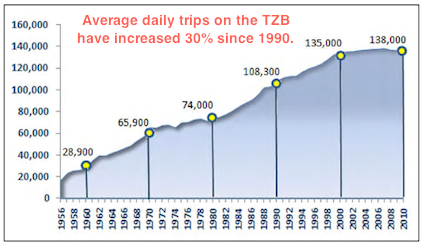by Cap’n Transit
 Whenever I see a wasteful road project, one of my first responses is to look for ways that the same trip could be made by rail. I tried to do that for the Tappan Zee Bridge. Going from Rockland or Orange to the city? We can dig the Gateway Tunnel. Going from New Jersey to New England? We can have the Cross-Harbor Rail Freight Tunnel, or we can reactivate the Poughkeepsie Bridge. Then I saw this chart, which has stumped me for months:
Whenever I see a wasteful road project, one of my first responses is to look for ways that the same trip could be made by rail. I tried to do that for the Tappan Zee Bridge. Going from Rockland or Orange to the city? We can dig the Gateway Tunnel. Going from New Jersey to New England? We can have the Cross-Harbor Rail Freight Tunnel, or we can reactivate the Poughkeepsie Bridge. Then I saw this chart, which has stumped me for months:
 In response to a question from Bbnet on a post from January, I dug up the survey summary, which says:
In response to a question from Bbnet on a post from January, I dug up the survey summary, which says:On an average weekday, 80,457 people cross the Tappan Zee Bridge in the eastbound direction. … The majority of the person trips (65 percent) originate in Rockland and Orange counties, with 42 percent coming from southern Rockland County alone. The remaining person trips either begin in New Jersey (24 percent) or locations external to the study region (11 percent)…
In terms of where trips end, slightly more than half (51 percent) of all the eastbound person trips over the Tappan Zee Bridge terminate in Westchester County. Approximately 28 percent of the trips end in New York City (16 percent in the Bronx, 7 percent in Manhattan, and 5 percent in other areas of the City), which includes those person trips commuting on the Hudson Line from the Tarrytown Station. The remaining person trips terminate in Connecticut (10 percent), Long Island (3 percent), Putnam and Dutchess counties (1 percent), and in locations external to the New York metropolitan area1 (7 percent).
Hmm, well it looks like the Gateway Tunnel, the Cross-Harbor Tunnel and the Poughkeepsie Bridge won’t be much help to these people. 65% are coming from Rockland and Orange Counties, but if we add up Westchester, Putnam, Dutchess, the Bronx and Connecticut we get at least 78% of commuters who wouldn’t be able to take advantage of those options. For those commutes, the only place you can really cross is at the Tappan Zee.
The liberating moment came when I realized that just because you can do something doesn’t mean you should. We have a word for the style of residential development that’s been built in Orange, Rockland and Bergen counties over the past fifty years. We have a word for the style of commercial development that’s been built in Westchester and the north Bronx since 1960. That word is sprawl.
There are several reasons why sprawl is a dirty word among environmentalists. Car-centered development pollutes the air, causing asthma and global warming. Incessant driving kills people, pets and wildlife. Sprawl wastes a tremendous amount of space, separating people from each other and causing obesity. Driving everywhere uses energy much faster than our planet gets it from the sun.
We see this in Orange, Rockland and Bergen counties, which have high crash fatality rates (33, 19 and 16 deaths per ten thousand inhabitants, respectively) and high rates of car travel per capita (12,682, 9,269 and 10,237).
The sprawl in Orange, Rockland and Bergen counties did not just appear. People built it because there were buyers, and those buyers came because they could drive to work. They could only drive to work because of the bridge. It’s a sprawl-generating machine.
Reduce the capacity of the bridge, and you reduce the demand for sprawl. Tear down the bridge, and you eliminate a good chunk of the demand for sprawl.
Rebuild the bridge, on the other hand, and you continue that demand for sprawl. Widen it, or even just “bring it up to modern standards” so that people can drive fast, and you increase the demand.
Why are we doing this again?
Cap’n Transit, who was born in New York and grew up in the Hudson Valley, west of the river, writes about mass transit in the NYC metro area at CapnTransit.Blogspot.com. He feels that eliminating government incentives for people to drive, and to help transit compete fairly we can “reduce disease, injury and death; improve energy efficiency; bring communities back together; and make access to work, shopping and entertainment fairer.”
His most recent article, The Tappan Zee Bridge is a sprawl-generating machine is timely read right before next Thursday’s public meeting at the Palisades Center to present a revised vision of a new Tappan Zee Bridge. Although the original $16B plan featured Commuter Rail and Bus Rapid Transit, but that vision has been downsized to only mention mass transit as a “future possibility.”









